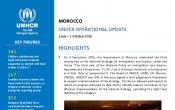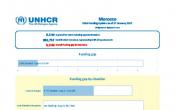Morocco
Operation: Morocco
Location
{"longitude":-7,"latitude":32,"zoom_level":0}
Latest update of camps and office locations 21 Nov 2016. By clicking on the icons on the map, additional information is displayed.
Key Figures
| 2016 end-year results | |
| 76% | of school-aged refugee children were enrolled in primary or secondary education, and families were provided with cash |
| 4,000 | new asylum claims were processed |
| 125 | refugee households were assisted through income-generation projects |
| 2017 planning figures | |
| 100% | of registered refugee children of school age will receive regular financial assistance for their education |
| 4,600 | new asylum-seekers and refugees will be registered with UNHCR |
| 2,300 | refugee referrals to public primary health centers will be conducted |
| 700 | vulnerable refugee families will receive financial assistance on average every month |
| 90 | refugees will benefit from support for income-generating activities |
Latest Updates
People of Concern
23%
Increase in
2016
2016
| 2016 | 6,733 |
| 2015 | 5,473 |
| 2014 | 3,048 |

[["Refugees",4771],["Asylum-seekers",1962]]
Loading ...
Morocco
< Back
2016
{"categories":[2012,2013,2014,2015,2016,2017],"budget":[2.76386772,3.26822619,3.57777971,4.166918764,6.46554855,6.80172728],"expenditure":[2.19370673,2.18764167,2.81881231,3.06590613,4.53949401,null]}
{"categories":[2012,2013,2014,2015,2016,2017],"p1":[2.76386772,3.26822619,3.57777971,4.166918764,6.46554855,6.80172728],"p2":[null,null,null,null,null,null],"p3":[null,null,null,null,null,null],"p4":[null,null,null,null,null,null]}
{"categories":[2012,2013,2014,2015,2016,2017],"p1":[2.19370673,2.18764167,2.81881231,3.06590613,4.53949401,null],"p2":[null,null,null,null,null,null],"p3":[null,null,null,null,null,null],"p4":[null,null,null,null,null,null]}
Loading ...
CHOOSE A YEAR
- 2015
- 2016
- 2017
Working environment
The protection environment for refugees and asylum-seekers in Morocco continued to be favourable. Refugees and asylum-seekers registered with UNHCR are residing in over 40 cities in Morocco and originate from over 30 countries. This is a positive trend with respect to achieving local integration, but also presents a challenge for the Government, UNHCR and partners to identify the most vulnerable.Pending the establishment of a national asylum system, UNHCR continued to register asylum-seekers. Refugee status determination was undertaken jointly with the Moroccan authorities with the aim to also strengthen government capacity.
Morocco’s new migration and asylum policy and second regularization campaign, launched in December 2016, benefits people of concern by facilitating access to basic services such as education and health care, as well as to the job market.
Population trends
- In 2016, the number of refugees registered with UNHCR increased by 22 per cent to 4,772 people.
- The number of asylum applications from non-Syrian nationals increased by 40 per cent in 2016 compared to 2015.
- UNHCR expanded its partner network to reach people of concern. One-third of all new asylum applications in 2016 were referred to UNHCR by NGO partners in northern border areas.
- UNHCR increased its use of cash-based interventions to increase the reach and utility of its assistance, in particular to refugees residing in remote areas.
- Two agreements signed with key academic institutions to promote the inclusion of refugee protection in existing curricula, to increase future law practitioners’ knowledge on asylum issues
- UNHCR provided detailed comments on the latest version of the draft asylum law upon the request of the Government of Morocco.
Unmet needs
- Due to insufficient funding and the increasing number of refugees, UNHCR could not assist all refugees in need of secondary medical care, which led to serious health complications.
- UNHCR was only able to cover half of the transport costs for the most vulnerable asylum-seekers being referred from the border areas to Rabat for registration (the only location where the service is available), thereby limiting the possibility for many to apply for asylum.
- UNHCR was only able to assist two-thirds of refugees identified to be in need (125 individuals) with income-generating activities.



